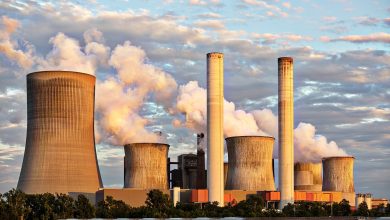What the Future Holds in Store for Coal

Once known to have fired up the industrial age, it is now being pushed away as a toxic pollutant. Many countries are decreasing their coal consumption. In the past many decades, coal has contributed immensely to the economic development of countries, thereby helping people come out of poverty and thrive. Since 2000, the global usage of coal increased by approximately two-thirds, with China and India driving the coal industry. The global coal trade too increased two-fold to touch 1.5 billion tons each year during this phase. Australia and Indonesia were among the few coal suppliers, while Japan and South Korea formed the major importers of coal. Coal, however, has been accused of causing air pollution and global warming. The future of coal today is a little uncertain, but it still seems promising enough.
Coal and Air Pollution
Coal-fired power plants are said to cause air pollution, leading to asthma, heart and lung diseases, cancer, and neurological disorders, among others. Burning of coal is also associated with global warming, acid rain, and many other hazardous health results. Acid rain produces acid in lakes and streams and destroys ecosystems and crops.
Even though coal is undoubtedly a reliable energy source, it comes at a heavy cost. The chemical bonds that keep the carbon atoms in its place are broken when coal burns, thereby letting go of energy. Unfortunately, while coal enables us to produce energy, the breaking of carbon molecules produces toxic pollutants and heavy metals that adversely affect our health.
Air pollutants are comprised of:
- Mercury: Coal plants are accountable for more than 40 percent of the emissions of mercury. Mercury is an extremely toxic metal that can destroy your nervous, immune, and digestive systems, and can pose a grave threat to the development of a child. The gravity of the situation can be understood by simply citing that a mere 1/70th of a teaspoon of mercury deposited in a 25-acre lake can make it unsafe for us to consume the fish inside.
- Sulfur dioxide: Sulfur dioxide (SO2) is a chemical that is emitted when the sulfur present inside the coal reacts with the oxygen in the atmosphere. SO2 then mixes with other molecules in the environment and goes on to create acid and tiny particulates that are small enough to get inside our lungs. Sulfur dioxide is associated with acid rain, asthma, bronchitis, and smog.
- Nitrogen oxides (NOx): Nitrous oxides aggravate asthma, create irritation in the lung tissue, and expose people to persistent respiratory illnesses like influenza and pneumonia.
- Particulate matter: Particulate matter, popularly referred to as soot, is the ashy grey matter that emits from coal smoke. The particulate matter can be associated with asthma and chronic bronchitis. It is also linked to premature death and cardiovascular illness-causing heart attacks.
It is possible for pollution controls to keep a check on and reduce these emissions drastically. Many plants, however, do not have the required controls installed. It is the responsibility of America’s Environmental Protection Agency (EPA) to impose limits of emission for harmful pollutants. The authority has been granted to the EPA under the Clean Water Act, Clean Air Act, and several other environmental laws.

Coal and Global Warming: The Connection
Coal was a very important fossil fuel in America not long ago, and hence, it was responsible for over 40 percent of electricity in the country at one time. People, however, are slowly beginning to move away from coal, as it is now being linked to creating pollution and damaging the environment. Global warming is one of the most harmful and irreversible impacts of coal burning. It is caused by the release of heat-trapping gases that happens due to our activities. These gases go into the environment and form a blanket like a filament, thereby warming the surface of the earth. The effects of global warming comprise quick and steady rise in sea level and increased temperatures. Other consequences of global warming include storms, heavy rains, heat waves, drought, and loss of species. Climate change can cause massive ecological disruption and the number one problem facing mankind if nothing is done to stop it.
Coal’s main effects that are causing damage to the environment include:
- Carbon dioxide: The emission of carbon dioxide (CO2) caused by burning fossil fuels is the main reason behind global warming. The unimaginable impact it has on global warming is clear from the statistics gathered by researchers. Every gram of coal combustion produces approximately four grams of CO2. Depending on the kind of coal, this fossil fuel can carry 60 to even 80 percent carbon.
- Methane: Methane (CH4) is emitted during mining activities. CH4 is said to be 34 times stronger than carbon dioxide when it comes to trapping heat in a period of 100 years. Approximately ten percent of methane emissions come from coal mining.
Global warming will persist until the world decreases the emission of carbon. Carbon emission takes place because most countries burn coal , which is the underlying reason behind 45 percent of the global carbon emissions. According to the U.S. Energy Information Administration, the use of coal will increase from 30 percent, which is today, to nearly 50 percent by 2035.
Role of Coal in Economic Growth
Fossil fuels, which includes coal, will continue to be one of the major sources of global energy. Growth in income and rising levels of population are the reasons behind this growing need for energy. World population is predicted to touch 8.8 billion by 2035, with world GDP possibly doubling up. An excess of nearly 1.5 billion people are likely to need energy.
Coal is available in plenty and is hence the most reliable fossil fuel resource. Coal is the main source of electricity supply, as it takes care of more than 40 percent of the world’s electricity requirements. It is also used extensively to produce concrete and steel. Sustainable development requires energy to help build a tough community with all essential amenities, like hospitals and schools. It further helps industries and companies to provide employment, thereby aiding in economic growth. It must be noted here that coal mining provides jobs to over seven million people globally.
There are nearly 1.3 billion individuals in this world without access to electricity. Unless concrete actions are taken, nearly one billion people will be denied access to electricity by 2035. Easy access to energy is required, and coal is that easy access.
More than one-third of excess energy will be required by the world in the next ten to twenty years to meet the rising level of energy requirements. Coal, as per the International Energy Agency (IEA) and the U.S. Energy Information Administration (EIA), will play a massive role in meeting the increasing energy needs of the world in the coming two decades. That will enable the world to grow and provide people with income and a better standard of living.
New Coal Technology
In spite of all the attention and financial aid that the wind and solar power industries receive from the government, the development and implementation of new coal technologies will decide the future of energy. Even though there is uncertainty, there is no doubt that fossil fuels, including coal, will continue to be the spine of the global energy system.
The United States alone is working on several new and advanced coal technologies. One of the well-known coal technologies being implemented by coal industries in the U.S. is the pulverized coal combustion system. The system, functioning at very high pressure and temperature, works on an integrated gasification combined cycle. By raising the efficiency rate of the U.S. coal fleet from 33 to 40 percent, we would be able to decrease coal-plant emissions by 14 degrees to 21 percent with the help of this technology.
Many other technologies being developed by leading researchers in the U.S. and other countries suggest innovative techniques that help capture carbon emissions from power plants, such as natural gas units and coal. The emissions can be used to produce plastics, petrochemicals, and many other useful items and products.
Many projects are underway even though there are many challenges in developing suitable technologies to capture carbon.

Clean Coal to Reduce Environmental Hazards
Coal meets a minimum of 27 percent of primary energy needs and around 38 percent of electricity needs. Moreover, 70 percent of global steel production depends on coal. Coal is available in plenty in nature and is the cheapest source of energy. Burning the coal, however, releases more than 14 billion tonnes of CO2 every year.
The clean coal technology is a new-age energy-producing technique. While some of these techniques are already developed, many are still in the production stage. These new techniques enable power plants, both old and new, to create power in an economical and environmentally friendly manner.
The following are the techniques that are being opted to create clean coal:
- Optimization of the current existing plants so that they can help reduce emissions and raise the electricity amount produced without increasing the coal amount
- Continuing to improve the existing combustion technology, which could also include burning biomass, thereby decreasing carbon emission levels, and oxy-combustion to collect carbon dioxide-rich flue gas
- Implementing a new gasification process to change coal into gas and taking out impurities from the coal gas before the process of combustion takes over
- Capturing carbon dioxide (from flue gas) and saving it underground to reuse it later known as carbon capture and storage (CCS)
US Coal Production on a Decline
The coal production in the United States of America is likely to shrink in the next few years even though it might not last long. The shrink might happen because of coal’s weak performance when compared to the natural gas in the electric power sector and low opportunities in the coal export area.
The coal production in the United States of America reduced by three percent in 2019, and it went to as low as 729 million tons. This is in sharp contrast to 2018, as per the U.S. Energy Information Administration’s review. Even though the United States of America raised the natural gas power share in the utility-scale electricity generation, the share of coal is said to fall from 28 percent to 24 percent by late 2020, which is a sharp decline. The agency has always undermined the reduction of all forms of energy generation in all its forecasts. The agency is now of the opinion that the seaborne requirement will not give much of a cushion to the coal producers of the United States of America. This is evident from the fact that the entire exports of steam call and metallurgy drops heavily from 116.1 million tons in the year 2018 all the way down to 102.4 million tons in the next year. The year 2020 will see a massive dip, likely down to 94.4 million tons.
The coal exports in the Appalachia region witnessed a huge decline in the past many years. However, the country’s coal production increased multifold for the second year in 2018 even though production fell deeply in other parts of the United States of America.
There is no doubt that the Central Appalachia has profited a lot from the metallurgical demand for coal. Similarly. many other coal operators from across the other states of the U.S. have mentioned the increase in exports of thermal coal over the years. However, the supply of both types of coal is expected to decline, as production from Appalachia falls from 201.5 million tons in 2018 to 170.1 million tons in 2020, according to the EIA forecast.
Mark Levin, an analyst with Seaport Global Securities, explains that the price of metallurgical coal stayed string at the start of 2019, but then it slowly began to weaken. He also stated that the only way the prices were likely to hold strong was if there were a global supply disruption.
He went on to say that, in 2019, the supply side would stay well contained, and it is the demand side that we should be worried about. If the production and utilization of blast furnaces reduces at all, the met price will be affected.
The analyst also projected that coal exports in 2019 would decline to 113 million tons, which is actually an optimistic outlook, considering that EIA expected it to fall to 102.4 million tons. Levin also stated that the total coal production in the U.S. would be 758 million tons, as opposed to the 729.5 million tons projected by the EIA.

Efforts to Manage Waste
Coal-burning, which is done to generate power, produces many different wastes that must be controlled at any cost. The clean coal technology that we mentioned above is a product of today’s environmental concerns, and that includes global warming caused because of the massive release of carbon dioxide in the atmosphere. Many of the processes that are implemented in this new clean coal technology has in fact been used for several years.
Listed below are some of the elements that have been practiced for decades:
- Washing coal to clean it is the usual norm in developed countries, as it decreases ash and sulfur dioxide emissions when the coal is burned.
- Fabric filters and even electrostatic precipitators can altogether eliminate at least 99 percent of the fly ashes from these flue gases. This technique is used by many countries worldwide.
- The desulfurization of the flue gas decreases the sulfur dioxide output in the atmosphere by up to 97 percent, which is a great achievement. The result, however, depends on the sulfur levels present in the coal and the reduction extent. It is used extensively in developing countries whenever required.
- The use of Low-NOx burners enables coal-fired plants to decrease the emissions of nitrogen oxide by up to 40 percent. When combined with re-burning techniques, it is possible to decrease NOx by 70 percent. Moreover, selective catalytic reduction technique helps clean up at least 90 percent of emissions from NOx.
The Future of Coal
Coal is the most attractive form of energy since it is less expensive and found in abundance in nature. The value of coal is likely to increase in the next decade or two as technologically advanced coal plants, designed to capture carbon, get ready to meet the growing energy requirements of the world without causing any damage to nature and reducing greenhouse emissions.
Coal and many such solid fuels will most certainly remain a very important source of the world’s growing energy needs. Coal provides the nation with low-cost electric power sources, and hence, the world is slowly looking at clean coal technologies to make use of this naturally available resource in the most responsible manner. The new technology promises to balance the environmental, as well as the economic, concerns and also provide the world with the necessary energy output. The future of coal is hence promising, even though it might seem uncertain at the moment.



